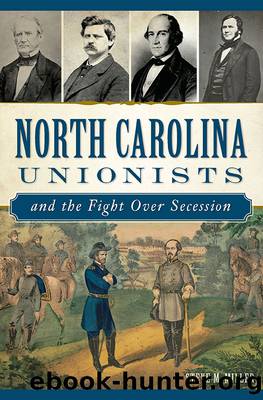North Carolina Unionists and the Fight over Secession by Miller Steve M.;

Author:Miller, Steve M.;
Language: eng
Format: epub
Publisher: Arcadia Publishing
Published: 2019-08-15T00:00:00+00:00
5.
UNIONISTS IN NORTH CAROLINA
Although the citizenry of North Carolina seemed compelled to accept the results of the recent election, some political leaders, especially within the Democratic Party, were not. When the state legislature met in Raleigh on November 19, 1860, the first signs that the Democratic majority could be swayed by Secessionists came to light.
One of the stateâs leading Secessionists, Thomas L. Clingman, a former Whig, was elected to the U.S. Senate. Secondly, Democratic leaders took the choice job of state printer from the editor of the Raleigh Standard, William Holden.152
During much of the 1840s and 1850s, Holden had been one of the shrillest voices in favor of state rights, revolution and secession, until the calamity appeared to be a real possibility. Suddenly, he made an abrupt about-face and became an ardent Unionist.153 More than once, Holdenâs hopes had been dashed that he might be the Democratic nominee for governor. He had not been able to secure his partyâs nomination for that post. Perhaps discontent was part of his change of heart.
One longtime Unionist, Jonathan Worth, a North Carolina state senator at the time, was obviously concerned about Clingmanâs election to the U.S. Senate. Worth said that it âawakens painful reflections in every lover of Union, whose patriotism raises him above the influences of party.â154 Worth and a fellow state senator, Bedford Brown, were not only concerned about events in North Carolina, but were also troubled about the Secession Convention to be held in South Carolina in December.
Brown, a leader in the North Carolina legislature, introduced a resolution on December 10 designating Thomas Ruffin, Weldon H. Edwards, William A. Graham and William N.H. Smith to attend the South Carolina convention on December 17. Once there, these commissioners to the Palmetto Stateâs convention were to ask âto suspend any action by which secession from the Confederacy shall be accomplished,â hoping instead that a convention of all the states could be held.155 Unionists felt that this approach would allow for a cooling-off period and perhaps offer a forum for the delegates to talk openly and frankly.
Ultimately, however, Brownâs resolution became bogged down in a mass of amendments and counter-amendments. Each side, Secessionists and Unionists, attempted to insert language that would have made it almost impossible for their opposition to vote for the resolution. Finally, three days before South Carolina was to meet in convention, Brown withdrew his motion.
North Carolina Secessionists like U.S. senator Thomas Clingman, former U.S. House member William Avery and Governor John W. Ellis were eager to test the secession idea. The most pro-secession newspaper in the state was the Wilmington Journal, which was located in the slavery-entrenched county of New Hanover.156 When South Carolina finally seceded on December 20, 1860, these forces ramped up their rhetoric and began pushing for the Tar Heel State to follow the Palmetto Stateâs lead.
During the state legislatureâs Christmas recess, public meetings were held in order for elected officials to hear the voices of the people around the state. One such meeting was held in Asheboro on December 28.
Download
This site does not store any files on its server. We only index and link to content provided by other sites. Please contact the content providers to delete copyright contents if any and email us, we'll remove relevant links or contents immediately.
The Secret History by Donna Tartt(18088)
The Social Justice Warrior Handbook by Lisa De Pasquale(11943)
Thirteen Reasons Why by Jay Asher(8418)
This Is How You Lose Her by Junot Diaz(6412)
Weapons of Math Destruction by Cathy O'Neil(5802)
Zero to One by Peter Thiel(5464)
Beartown by Fredrik Backman(5310)
The Myth of the Strong Leader by Archie Brown(5219)
The Fire Next Time by James Baldwin(4998)
How Democracies Die by Steven Levitsky & Daniel Ziblatt(4943)
Promise Me, Dad by Joe Biden(4900)
Stone's Rules by Roger Stone(4836)
100 Deadly Skills by Clint Emerson(4670)
Rise and Kill First by Ronen Bergman(4537)
A Higher Loyalty: Truth, Lies, and Leadership by James Comey(4534)
The David Icke Guide to the Global Conspiracy (and how to end it) by David Icke(4362)
Secrecy World by Jake Bernstein(4357)
The Farm by Tom Rob Smith(4308)
The Doomsday Machine by Daniel Ellsberg(4234)
